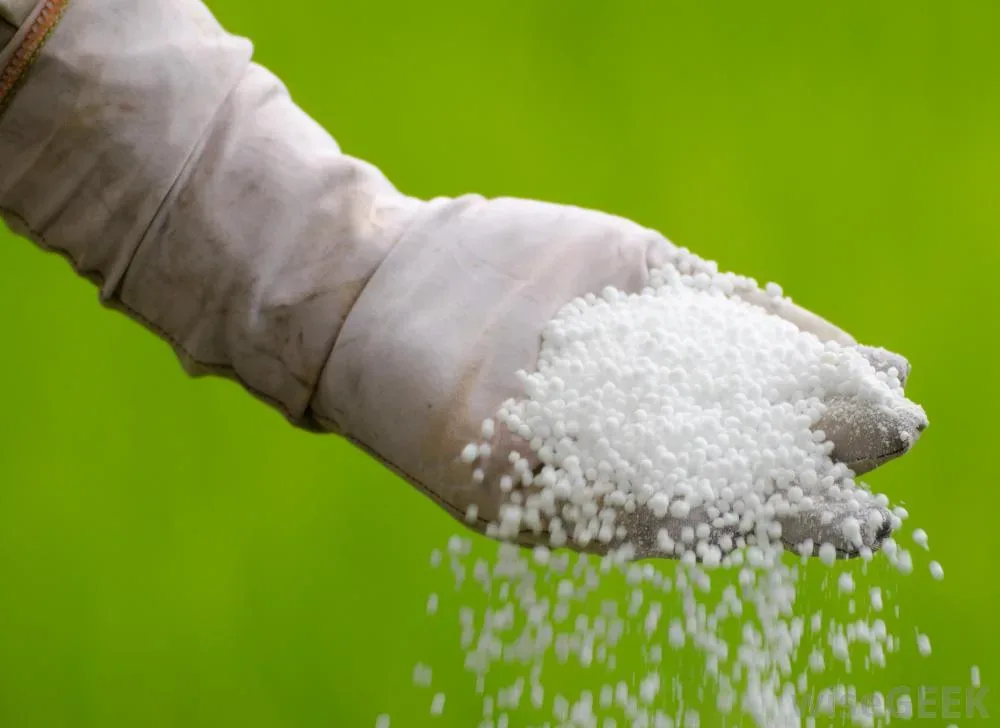
Written by davethetreecenters • September 23 What Is Urea?
Urea is a form of nitrogen that is made in the kidneys to excrete excess nitrogen, mostly from eating protein, which cannot be stored in the body. It is also manufactured on a large scale for use as a fertilizer, although there are some other uses in explosive making, medicine and even cleaning car exhaust gases.
Almost all the urea manufactured is converted into urea-formaldehyde, which is the most common type of nitrogen fertilizer used in agriculture and gardening.
Urea is very soluble in water, so if applied as a fertilizer by itself only a very small amount can be used and it will quickly be carried away in drainage. The urea cannot be used directly by plants but it is naturally converted into ammonia on contact with water in the soil. This then dissolves in the water and can be absorbed by plants for growth. Nitrogen is needed by plants to make protein and also to make chlorophyll, the green pigment in plants used to trap light and make sugars to grow.
However, if there is too much urea or ammonium in the soil it will draw water out of the roots and cause ‘fertilizer burn’, with the leaves shriveling and dying, often also killing the plant. This means that pure urea must be applied in very small amounts very often to be effective as a fertilizer. This is also what happens when dogs or cats urinate on your lawn.
Methods For Slowly Releasing Urea
So scientists worked on ways to save the cost and labor of these frequent small applications. They developed two methods of slowing the release of urea.
Water-Resistant Coating
The first method adds a water-resistant coating to a granule of urea and is called controlled-release. Examples are Nutricote™ and Osmocote™. These forms have a resin or polymer coating to slow down the release. Release of nitrogen is mostly influenced by temperature and higher temperatures accelerate the release. This is usually a good thing, since during warm weather when plants are growing more will be released, but in cooler weather less will be released, matching the growth of the plants and preventing pollution of drainage water. These granules are often found in fertilizers that last a whole season and are great for pots and planters. Other plant nutrients are added to make a complete fertilizer.
A less-expensive type of coating is SCU (sulfur-coated urea). Here the urea granules are coated with molten sulphur, wax and then clay. The activity of soil microbes and water penetration through cracks in the coating allow the urea to escape into the soil. This material is cheaper to manufacture, so it is widely used in lawn fertilizers. Be careful handling lawn fertilizer, because if the granules are crushed they will release all the urea at once and cause burn which could kill the lawn.
Urea-Formaldehyde
For cheaper fertilizers, especially for agriculture, the urea is turned into a less-soluble form called urea-formaldehyde. This does not contain the formaldehyde used to preserve dead animals. Since this does not immediately dissolve in water, it will stay in the soil as a solid until it is broken down. The molecules of urea-formaldehyde are of different sizes, depending on how exactly they are manufactured, and they have different degrees of solubility in water, affected by temperature.
As well, soil microbes are needed to break down this material so plants can absorb it. Microbes are also more active at higher temperatures, so overall the rate of release of the fertilizer depends on the temperature, since both solubility and the amount of microbe activity is influenced by the soil temperature. Release is very slow below 50 degrees, so this material can be applied to lawns and gardens in the late fall. No nitrogen will be released until the soil warms up in the following spring, and a spring fertilizer application is not needed– a job saved at a busy time of year.
Should I Use Urea On My Plants or Lawn?
So you probably did not know that when you use a fertilizer on your trees, your lawn, your vegetables or your flowers, you are probably using urea in one form or another. Because it is also present in urine, there are those who suggest peeing on your compost heap is a good idea. The choice is yours!
These kinds of fertilizers are essential for large-scale agriculture to feed a constantly growing world population. Chemically speaking what the plant takes up through its roots is identical, no matter where it came from. Organic material is essential for preserving the quality of the soil, but it is an often inefficient way to give plants nitrogen. If chemical fertilizers are used wisely they can be a great benefit to humanity.





